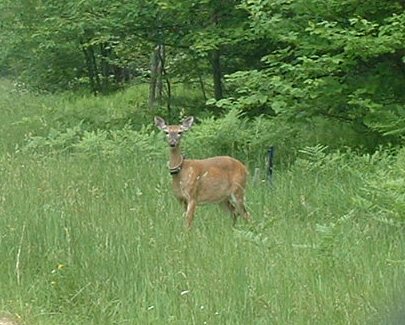In previous posts I wrote about why males disperse – to minimize inbreeding and to seek areas with less competition for mates. And another post covered how far and fast they disperse. Today I am going to focus on female dispersal – dispersal is defined as the movement of a deer from its natal home range (where it was born) to a new home range where it resides as an adult.
Surprisingly, yes, females do disperse! And it has been studied a fair amount. The first study was in 1970 when two researchers in Illinois reported dispersal rates in female deer of 13%. But most research on female dispersal was not published until the 1990s, probably because that’s when radiocollars became less expensive and more reliable.
In Pennsylvania, we began radiocollaring female deer in 2005. Between 2005 and 2011 we captured 277 8-month-old females and fitted them with radiocollars. These deer were captured in northeastern (WMU 3C), northcentral (WMU 2G), western (WMU 2D), and southcentral (WMU 4B) Pennsylvania.
The graduate student heading up this project, Clay Lutz, discovered some interesting things about female dispersal.
Clay was able to monitor 229 of the 277 juvenile females during the dispersal period and found that 12% (27 females) dispersed – compared to about 75% of males that dispersal rate is low. But he found quite variable dispersal rates among WMUs. Dispersal rates ranged from 9% (WMU 2G) to 32% (WMU 2D). That 32% dispersal rate is almost half the rate of males!
Dispersal occurred mostly during the spring fawning period – 25 of 27 females dispersed between May 2nd and July 7th. The other two females dispersed March 19th and November 13th. The female that dispersed during the rut in November dispersed with her male sibling!
Female dispersal movements were also quite different when compared to males. If you recall, dispersal in most males from start to finish takes under 12 hours. And their path is a near straight line.
Not females.
The average dispersal distance was 11.2 miles, with the longest distance being 32.8 miles. But this is where it is really interesting. Dispersal was not straight. Even though the average straight-line (“as the crow flies”) dispersal distance was 11 miles, the average path it took to go those 11 miles was 32 miles!
And it gets better.
The average time it took a female to disperse was 350 hours (14.5 days)! And the longest was 55 days!
To show you how tortuous and complex female dispersal movements can be, here is an example from Perry County.
This female was born along the Juniata River just north of the confluence of the Susquehanna and Juniata rivers at Clarks Ferry. Route 322 goes along the Juniata River on the east side and trains travel the west side of the river. You can see Route 11/15 cross the Juniata River near the bottom of the photo.
On May 12th this female left her mother’s home range (yellow locations), headed south, and stopped at Route 11/15. Roads can be barriers to dispersal and this female decided to head north back home.

But on June 6th she again left home and headed back south to Route 11/15

But this time she figured out how to cross the road (she may have gone underneath the road where it passes over the railroad tracks. And she crossed the Juniata River – only to encounter another barrier! If you’re familiar with Clarks Ferry you know that just north of the bridge is a collection of businesses and a very busy Route 322. She crossed the river but she was not about to cross the busy road.

So instead she headed back across the Juniata River and south along the railroad tracks in Duncannon!

And kept going south. Crossing Sherman Creek along Route 11/15.

The next day she ended up on Cox Island.

So it looks like she wants to head east, but just can’t find the right spot to cross the river. She keeps going south and ends up on the north side of Marysville.
By the way, the large island in the center of the river (photo below) is Berrier Island – named after the family of the very first Game Protector for the Pennsylvania Game Commission.

Here she skirts the north edge of town and heads west a bit.

But she turns north and crosses Berrier Island and finds herself on the east shore of the Susquehanna River. And what does she find there? Railroad tracks and a large retaining wall for Route 322 blocking her path.

Dispersal is risky business for females. Two of 27 died while dispersing (7%), which is pretty high compared to the 212 dispersing males we monitored and only 1 died (less than one-half of 1%). And that’s what happened to this female – she started her dispersal journey on June 6th and 12 days later she was hit by a train and killed.
What is going on here? Why are females dispersing? That’s where the graduate student on the project, Clay Lutz, started asking those “Why?” questions. We’ll cover that in a future post.
-Duane Diefenbach
Previous post on this topic: So Why Did the Deer Cross the Road (or not)?
Next post on this topic: A Rose by Any Other Name
If you would like to receive email alerts of new blog posts, subscribe here.
And Follow us on Twitter @WTDresearch
